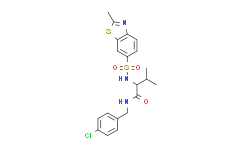| Cas No.: | 328968-36-1 |
| Chemical Name: | C646 |
| Synonyms: | C 646;C646 C-646 C 646;4-(4-((5-(4,5-Dimethyl-2-nitrophenyl)furan-2-yl)methylene)-3-methyl-5-oxo-4,5-dihydro-1H-pyrazol-1-yl)benzoic acid;C-646;(Z)-4-(4-((5-(4,5-dimethyl-2-nitrophenyl)furan-2-yl)methylene)-3-methyl-5-oxo-4,5-dihydro-1H-pyrazol-1-yl)benzoic acid;AC1LPE4V;CHEMBL1797936;MolPort-002-171-380;QCR-235;ST020490;4-[4-[[5-(4,5-Dimethyl-2-nitrophenyl)-2-furanyl]methylene]-4,5-dihydro-3-methyl-5-oxo-1H-pyrazol-1-yl]benzoic acid;C646 |
| SMILES: | O=C(O)C1=CC=C(N2N=C(C)/C(C2=O)=C\C3=CC=C(C4=CC(C)=C(C)C=C4[N+]([O-])=O)O3)C=C1 |
| Formula: | C20H22N3O3S2Cl |
| M.Wt: | 451.98998 |
| Sotrage: | 2 years -20°C Powder, 2 weeks 4°C in DMSO, 6 months -80°C in DMSO |
| Description: | C646 is a selective and competitive histone acetyltransferase p300 inhibitor with Ki of 400 nM, and is less potent for other acetyltransferases. |
| In Vitro: | C646 is a linear competitive inhibitor of p300 versus acetyl-CoA with a Ki of 400 nM. C646 shows a noncompetitive pattern of p300 inhibition versus H4-15 peptide substrate. C646 treatment reduces histone H3 and H4 acetylation levels and abrogates TSA-induced acetylation in cells. C646 has a more potent effect on cell growth than Lys-CoA-Tat does[1]. C646 enhances mitotic catastrophe after IR and suppresses phosphorylation of CHK1 after IRin A549 cells[2]. C646 attenuates the increased acetylation of GATA1 and the increased transcriptional activity of GATA1 induced by EDAG[3]. |

 To enhance service speed and avoid tariff delays, we've opened a US warehouse. All US orders ship directly from our US facility.
To enhance service speed and avoid tariff delays, we've opened a US warehouse. All US orders ship directly from our US facility.





















